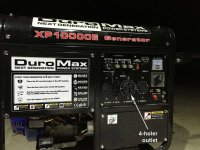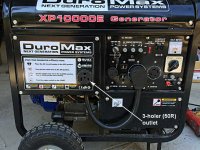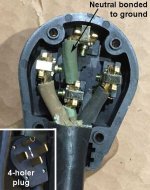The neutral and (safety) ground should never be tied together at the plug or socket. Agreed, ... they are tied together at the main electrical panel, but should not be tied together at the plug. The neutral serves no real purpose when using strictly 220/240 volts from a single appliance since the current enters one hot conductor and returns to the power company via the other hot conductor. However if that appliance has any part inside that runs on 120VAC, then the neutral carries the return current from one leg of the 240 volt lines back to the electrical panel. The (safety) ground should never have current on it except in a fault condition, which should then pass the fault current back to the electrical panel and trip the breaker. When you tie the neutral and the (safety) ground together at the plug, then there could be current flowing on the neutral/(safety) ground as a normal condition. In this case, this neutral/(safety) ground wire could come in contact with your body. Remember the ground wire is usually tied to the metal case of the appliance. If you are earth grounded and you touch the metal case of the appliance. You are now dead. End of story. You have suddenly stopped reading this post.
The NEC (National Electric Code) was changed years ago from requiring a 3 prong plug (hot, hot, (safety) ground) to now require a 4 prong (hot, hot, neutral, (safety) ground). The neutral and (safety) ground has to now be 2 separate conductors, not tied together. To my understanding this was done because certain appliances (like an electric stove or a clothes dryer) sometimes contained small clock motors that ran on 120 volts but the main appliance ran on 240 volts. Because the 120 volt clock motor passed current on the ground conductor on a continuous basis, this was considered a safety hazard that could kill you. The (safety) ground should never normally carry current on this wire except in a fault condition (to save your life). Now that these are tied together in you application, the case of your appliance could be energized with enough current that could kill you. It is strongly suggested that you do not tie these together, if you value your life or other lives that might use your appliance. Consult an electrician that truly understands the difference between neutral and ground. They are not the same even though they are tied to the same point in an electrical panel. They should never be tied to the same point on a plug or socket.
The above can be quickly and easily demonstrated if you want to be the (dead) guinea pig, otherwise, a simple volt meter can tell you that it could kill you. I hate to be a downer, but your wiring methods and NEC violations are serious enough that others should understand why this should never be done.
No, I am not a licensed electrician. I am an engineer.



